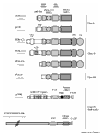Phosphoinositide 3-kinase signalling in breast cancer: how big a role might it play?
- PMID: 11597319
- PMCID: PMC138693
- DOI: 10.1186/bcr312
Phosphoinositide 3-kinase signalling in breast cancer: how big a role might it play?
Abstract
Phosphoinositide 3-kinase (PI3K) was first identified as a lipid kinase activity associated with the products of viral oncogenes and with activated protein-tyrosine kinases. Since those early studies, the PI3K superfamily has grown to embrace at least 12 structurally and functionally related enzymes present in the human genome, some of which have protein kinase activity but not lipid kinase activity. Evidence is emerging that PI3K superfamily members, and components of PI3K signalling, play a role in the development of many human cancers. In this review, the PI3K family of enzymes and their signalling is reviewed, with particular reference to possible involvement in breast cancer.
Figures


Similar articles
-
Structural Basis for Regulation of Phosphoinositide Kinases and Their Involvement in Human Disease.Mol Cell. 2018 Sep 6;71(5):653-673. doi: 10.1016/j.molcel.2018.08.005. Mol Cell. 2018. PMID: 30193094 Review.
-
Drugging the Phosphoinositide 3-Kinase (PI3K) and Phosphatidylinositol 4-Kinase (PI4K) Family of Enzymes for Treatment of Cancer, Immune Disorders, and Viral/Parasitic Infections.Adv Exp Med Biol. 2020;1274:203-222. doi: 10.1007/978-3-030-50621-6_9. Adv Exp Med Biol. 2020. PMID: 32894512 Review.
-
Type III phosphatidylinositol 4 kinases: structure, function, regulation, signalling and involvement in disease.Biochem Soc Trans. 2016 Feb;44(1):260-6. doi: 10.1042/BST20150219. Biochem Soc Trans. 2016. PMID: 26862213 Review.
-
Phosphatidylinositol 4-kinases.Eur J Biochem. 1998 Apr 15;253(2):357-70. doi: 10.1046/j.1432-1327.1998.2530357.x. Eur J Biochem. 1998. PMID: 9654085 Review.
-
Targeting the phosphoinositide-3 (PI3) kinase pathway in breast cancer.Oncologist. 2011;16 Suppl 1:12-9. doi: 10.1634/theoncologist.2011-S1-12. Oncologist. 2011. PMID: 21278436 Review.
Cited by
-
Neuroprotective Effects of Salidroside in the MPTP Mouse Model of Parkinson's Disease: Involvement of the PI3K/Akt/GSK3β Pathway.Parkinsons Dis. 2016;2016:9450137. doi: 10.1155/2016/9450137. Epub 2016 Sep 21. Parkinsons Dis. 2016. PMID: 27738547 Free PMC article.
-
Calcium regulation of keratinocyte differentiation.Expert Rev Endocrinol Metab. 2012 Jul;7(4):461-472. doi: 10.1586/eem.12.34. Expert Rev Endocrinol Metab. 2012. PMID: 23144648 Free PMC article.
-
mda-7/IL-24: multifunctional cancer-specific apoptosis-inducing cytokine.Pharmacol Ther. 2006 Sep;111(3):596-628. doi: 10.1016/j.pharmthera.2005.11.005. Epub 2006 Feb 7. Pharmacol Ther. 2006. PMID: 16464504 Free PMC article. Review.
-
The PI3K-Akt-mTOR and Associated Signaling Pathways as Molecular Drivers of Immune-Mediated Inflammatory Skin Diseases: Update on Therapeutic Strategy Using Natural and Synthetic Compounds.Cells. 2023 Jun 20;12(12):1671. doi: 10.3390/cells12121671. Cells. 2023. PMID: 37371141 Free PMC article. Review.
-
Combined effect of sCD40L and PI3K siRNA on transplanted tumours growth and microenvironment in nude mice with gastric cancer.Mol Biol Rep. 2012 Sep;39(9):8755-61. doi: 10.1007/s11033-012-1736-3. Epub 2012 Jun 27. Mol Biol Rep. 2012. PMID: 22736104
References
-
- Fry MJ. Structure, regulation and function of phosphoinositide 3-kinases. Biochem Biophys Acta. 1994;1226:237–268. - PubMed
-
- Roymans D, Slegers H. Phosphatidylinositol 3-kinases in tumor progression. Eur J Biochem. 2001;268:487–498. - PubMed
-
- Leevers SJ, Vanhaesebroeck B, Waterfield MD. Signalling through phosphoinositide 3-kinase: the lipids take centre stage. Curr Opin Cell Biol. 1999;11:219–225. - PubMed
-
- Stein RC, Waterfield MD. PI3-kinase inhibition: a target for drug development? Mol Med Today. 2000;6:347–357. - PubMed
Publication types
MeSH terms
Substances
LinkOut - more resources
Full Text Sources
Other Literature Sources
Medical

